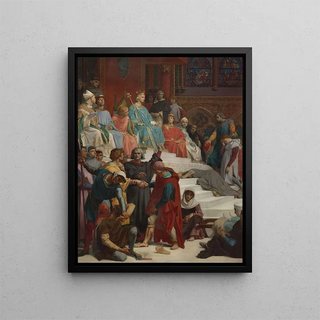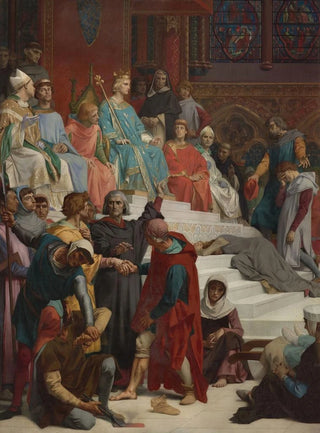Painting Saint Louis rendering justice - Alexandre Cabanel | Art print


View from behind

Frame (optional)
"Saint Louis rending justice" by Alexandre Cabanel embodies a captivating encounter between the sacred and the profane, an iconic representation of justice and wisdom. In this scene, King Saint Louis, a key figure of the 13th century, is depicted in a moment of great solemnity, administering justice with an authority tinged with compassion. This canvas, a true masterpiece of realism, offers a poignant glimpse into how art can transcend time, evoking universal values that still resonate today. The art print of this work not only allows admiration of Cabanel's technical virtuosity but also invites immersion into a universe where morality and responsibility come to life.
Style and uniqueness of the work
In "Saint Louis rending justice," Cabanel deploys a style that combines finesse and power. The light gently diffuses over the faces of the characters, accentuating expressions of devotion and respect that animate them. The king, majestic in his royal tunic, stands at the center of the composition, surrounded by courtiers and plaintiffs, each bearing the marks of their social status. The meticulous details, from sumptuous drapery to expressive faces, testify to a technical mastery that characterizes Cabanel's art. This painting does not merely depict a historical scene; it invites the viewer to reflect on the nature of justice and the role of leaders. The color palette, both rich and harmonious, gives the entire piece an atmosphere that is both serene and solemn, where each element contributes to the visual narration.
The artist and his influence
Alexandre Cabanel, born in 1823, is one of the most influential French painters of the 19th century. Raised in an academic tradition, he managed to combine the demands of his era with a unique personal sensitivity. His career, marked by success, places him at the heart of Parisian salons, where he became an essential figure of the neo-classical movement. Cabanel captured the spirit of his time while exploring universal themes such as beauty, morality, and the human condition. His influence is felt

Matte finish

View from behind

Frame (optional)
"Saint Louis rending justice" by Alexandre Cabanel embodies a captivating encounter between the sacred and the profane, an iconic representation of justice and wisdom. In this scene, King Saint Louis, a key figure of the 13th century, is depicted in a moment of great solemnity, administering justice with an authority tinged with compassion. This canvas, a true masterpiece of realism, offers a poignant glimpse into how art can transcend time, evoking universal values that still resonate today. The art print of this work not only allows admiration of Cabanel's technical virtuosity but also invites immersion into a universe where morality and responsibility come to life.
Style and uniqueness of the work
In "Saint Louis rending justice," Cabanel deploys a style that combines finesse and power. The light gently diffuses over the faces of the characters, accentuating expressions of devotion and respect that animate them. The king, majestic in his royal tunic, stands at the center of the composition, surrounded by courtiers and plaintiffs, each bearing the marks of their social status. The meticulous details, from sumptuous drapery to expressive faces, testify to a technical mastery that characterizes Cabanel's art. This painting does not merely depict a historical scene; it invites the viewer to reflect on the nature of justice and the role of leaders. The color palette, both rich and harmonious, gives the entire piece an atmosphere that is both serene and solemn, where each element contributes to the visual narration.
The artist and his influence
Alexandre Cabanel, born in 1823, is one of the most influential French painters of the 19th century. Raised in an academic tradition, he managed to combine the demands of his era with a unique personal sensitivity. His career, marked by success, places him at the heart of Parisian salons, where he became an essential figure of the neo-classical movement. Cabanel captured the spirit of his time while exploring universal themes such as beauty, morality, and the human condition. His influence is felt
12,34 €






